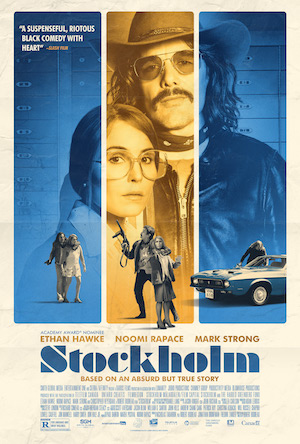
[Rating: Minor Rock Fist Up]

Wikipedia defines “Stockholm Syndrome” as, “a condition which causes hostages to develop a psychological alliance with their captors as a survival strategy during captivity…The term was first used by the media in 1973 when four hostages were taken during a bank robbery in Stockholm, Sweden.”
Stockholm is the dramatic retelling of this story (sort of). Instead of hewing close to the very interesting history of the real ordeal, writer/director Robert Budreau adopts only the most basic outlines of the actual events to create a film that is very much its own creature. And while Stockholm is indeed engaging and enjoyable, it feels like a great deal of interesting material is left untouched by the time the credits roll.
The movie opens in 1973 with wig-wearing, leather jacket-clad Lars Nystrom (Ethan Hawke) popping some speed and walking into a bank in Stockholm. With his heart racing like Jack Kerouac at the typewriter, Lars takes control of the bank, lets most of the hostages go, and then asks an employee to call the chief of police. Yep: Lars WANTS the cops there.
When confronted, Lars asks the police for money, a car, and a prisoner to be released from jail and brought to the bank. By the time this requested inmate arrives, the basics of Lars’ plan are laid bare: he’s just trying to get an old friend, Gunnar (Mark Strong), out of the clink before fleeing the country. The cops aren’t about to let some machine gun-toting hothead inspire other lunatics to take hostages to get what they want, though, and a stalemate ensues. And so, while Lars and Gunnar work through the realities of their terrible plan coming apart, a bank employee named Bianca (Noomi Rapace) begins to form a bond with Lars that transcends polite chit-chat.

Budreau wisely side-steps many of the same beats that audiences have seen since Dog Day Afternoon codified the popular notion of Stockholm Syndrome in cinema. Lars is a lovable idiot in way over his head, yes, and the bank’s staff does come to sympathize with him (this is patient zero for the phenomenon, after all), yet the film is less about the event than it is about the man and the hostage falling for him. This is a story about how stress and shared experience binds people together despite all the trappings of polite society that keep the assaulter and assaulted emotionally separated. Stockholm isn’t mining the drama of the scenario, but rather the souls of the participants, which paradoxically serves as the picture’s greatest strength as well as weakness.
Indeed, the main drawback of the film concerns characterization, and the ways Budreau eschews any deeper reading of the people or event by selectively eliminating almost everything not connected to Lars and Bianca’s budding relationship. Hawke’s character remains shrouded in mystery throughout most of the film, keeping the audience at arm’s length. And while this puts viewers in roughly the same position as the victims who come to sympathize with Lars, it doesn’t help when trying to open up this world. A brief moment passes when Bianca relates a story about Lars that she remembers from a newspaper article about him; before this, Bianca has a scene with her husband where she tearfully explains how to make dinner for the kids in case she dies. These represent rare instances of character exploration that do more to ground Lars and Bianca than anything that comes before or after. Stockholm could have used more of this to get the audience invested in its characters, yet the moments are fleeting.
It’s decent drama with highlights of comedy, yet Stockholm comes across as a little nebulous since it remains unmoored from the actual events. The names of the participants of the actual robbery are changed, and there’s little in the way of a postscript outlining what comes afterwards. After all, “Stockholm Syndrome” had less to do with the events of the robbery itself than it did with the trial that followed. The hostages famously refused to testify against their captors in court, kicking off the world’s fascination with the most notable syndrome to come out of Sweden. It’s an odd choice for Budreau, for if he isn’t going to develop his characters all that much, or stick to the history of the event (Hawke is very much an American, and his real-life counterpart wasn’t), then why even use the 1973 robbery as a template?

Hawke does wonderful work balancing his outward gasconade with the subterranean angst he’s most famous for on screen, and keeps the audience guessing about where his character will land at any given moment. Hawke has never been this dialed up in a movie before, and it’s a testament to his ever-increasing range as an actor that he’s able to pull it off so well. The counterbalance to Hawke’s performance comes from Rapace, who has the somewhat thankless task of playing the deer-in-the-headlights victim/sympathizer. She has to act most of her part with a quiet resolve that’s hard to penetrate, and only rarely pays off, yet like Hawke, she does about as well as anyone could with the script’s material.
On the whole, Stockholm does well for itself by keeping the tone light, and the pace clicking along at a good clip. And while there are certainly more interesting ideas to latch onto, and more avenues through which to explore them, the film does okay for itself. Bolstered by an against-type performance by Hawke, and a quiet but strong stabilizing turn by Rapace, Stockholm might just have a chance at culling viewers into its spell like the syndrome upon which it’s named.





Comments on this entry are closed.